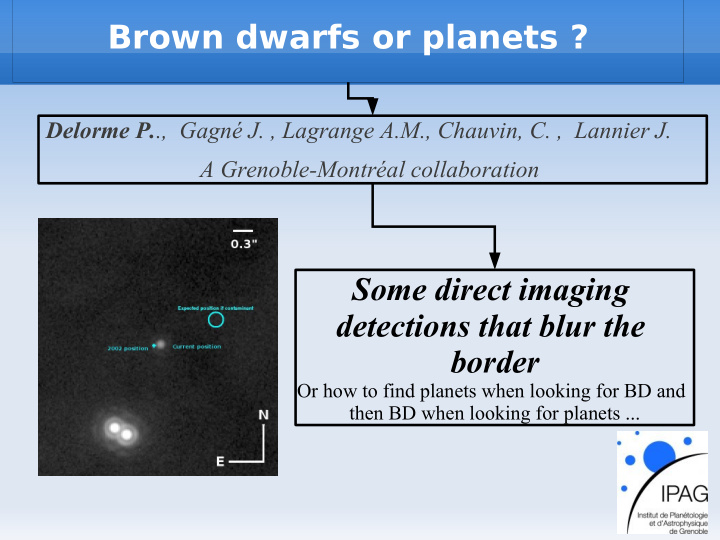



Brown dwarfs or planets ? Delorme P. ., Gagné J. , Lagrange A.M., Chauvin, C. , Lannier J. A Grenoble-Montréal collaboration Some direct imaging detections that blur the border Or how to find planets when looking for BD and then BD when looking for planets ...
From brown dwarfs to planets … CFBDSIR2149 Isolated point source in the CFBDSIR survey Identified as late T dwarf with weird colours Proper motion makes it a probable member of AB-Doradus ==> age 70-120Myr, mass = 4-7 Jupiter mass Planetary mass BD or HR8799-like ejected planet ?
A glance on a low-gravity T7-dwarf spectrum Observed spectrum Observed spectrum Field gravity model Low gravity model
AO imaging of young M dwarfs Why? Probe different stellar mass range, different planetary/brown dwarf formation regimes? Pros: Many nearby ones, favourable contrast Cons: Faint for the AO wave front sensor. Difficult targets Solutions: Use NACO InfraRed Wave Front Sensor. Use L' band to enhance sensitivity to the lowest planetary masses.
The Survey 56 young M dwarfs observed From M0 to M8.5 (young brown dwarfs) Ages between 8 Myr and ~120 Myr ~1hour per target in L', ADI.
Sensitivity Typical sensitivity is 1.5 Mjup @50AU Best sensitivity is 0.5Mjup @10AU 7 contaminants on 55 targets + more than 10 on 1 target (Chauvin et al. 2010 H and Ks: 240 candidates/36 stars)
Discoveries ! 12 tight binary <0.8'', in spite of biases against them. 0 Jupiter-mass planet 2 massive giant planets (?) and a brown dwarf, at large separations
Focus on 2MASS0103(AB)b
2MASS0103(AB)b Separation:1.8'' =84AU Orbital motion measured. Keplerian-compatible.
2MASS0103(AB)b is red L' (25 Nov. 2012) J band (25 Nov. 2012) Contrast is 19 in L', 29 in Ks and 66 in J
Comparison with other planets: colours
A probable member of Tucana-Horologium Similar approach as for the free-floating planet CFBDSIR2149 In this case 30 Myr ===> 12-14 Mjup object Right in the middle...
Comparison with other planets: spectra ---> Indeed a young object Analysis ongoing !
Comparison with other planets: mass ratio ---> Big mass ratio for a planet but very low mass ratio for a binary system
Formation ? Stellar ? Core fragmentation: possible but high mass ratio difficult to explain (ejection scenarios ~excluded) Planetary ? Core Accretion: almost impossible (too far, too heavy, too high mass ratio) Disc fragmentation: fits well with Boss et al. scenario but not necessarily with other scenarios => What is new is that separation is compatible with formation in situ in a disc.
Questions from statistics
Is zero a trend ? We found no planets lighter than 5Mjup We were sensitive to them =>There is still a small gap between RV and imaging where Jupiter mass planets around M dwarfs can exist, but the gap is small. => Are there Saturn mass planets ?
Is three a trend ? We found 3 objects with masses 5-20 Mjup, separations >50AU This is ~5+/-3% occurrence. People find even more distant ones. => Is it peculiar to low mass stars ?
Directly imaged core-accretion planets A few hundred of target stars, survey dedicated for planets imaged : - 1 planet that fits well with core accretion: Beta pic B (Lagrange et al 2009) - 2 (?) planetary systems that could fit with possibly formed by core-accretion, with some tweaking - HR8799bcde (Marois et al. 2008), Kappa And b. ( if age correct ) ( Carson et al. 2012) All around quite massive stars (1.5-2.5 solar masses)
Directly imaged other things... From the same sample of target stars : 2MASS1207B 5 Mjup around 25 Mjup BD Chauvin et al. 2004 ABpic B Chauvin et al 2005 13 Mjup @260AU TWA5 B Lowrance et al. 1999, 20 Mjup @ 100AU, M1.5 primary GQ Lup B, DH Tau B, and CHXR 73 B Luhman et al.2006 1RXS J160929.1 – 210524b , Lafrenière et al 2010 8 Mjup @330 AU; solar mass primary GSC06214-00210b : Ireland et al. 2011,300AU 12-15Mjup, M1 primary CD-35 2722B 30MJup; Wahaj et al. 2011, 65 AU M1 primary GJ 3629B , 5AU, 45 Mjup, Bowler et al. 2012, M primary 2M0103(AB)b Delorme et al. 2013, Janson et al. 2011 2 BD (rather massive) around young solar mass stars At least 12-15 low mass BD or very massive planets ( around several percents of targets), usually at large separation and around low mass stars A population distinct from planets and massive Bds ???
Directly imaged low mass BD and exoplanets From exoplanet.eu
Imaging Vs all the other (long Vs short separations) From exoplanet.eu Not a sensitivity issue between 5-15 MJup : different populations ?
Imaging Vs all the other Mass ratios From exoplanet.eu Tentatively different mass ratios : another hint for distinct populations ? Do we have a bump in the population of distant companions between ~5-20 Mjup ?
BDs : Viewed either as failed stars or oversize Jupiters Two main kinds of formation processes for which low mass Bds are overlapping extremes , but no bump possible in this view
BDs : A possible third way ? Two kinds of formation processes that may overlap in the low mass BD regime AND a BD-specific formation mechanism
Thanks !
Thanks !
Thermal imaging versus NIR
Recommend
More recommend